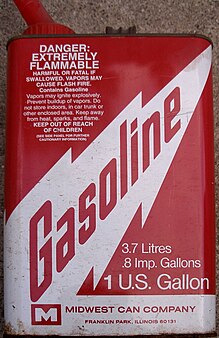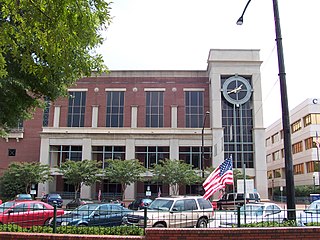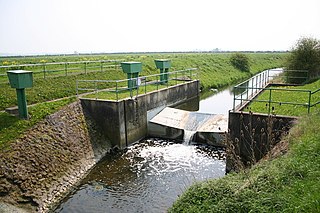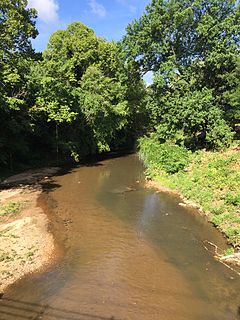The Noonday Water Reclamation Facility is a sewage treatment plant that processes around 20 million gallons or 75 million liters of sewage per day for northeast Cobb and southern Cherokee counties in north-northwest metro Atlanta, located in north-central Georgia. It is operated by Cobb's water system, which partly wholesales its service to Cherokee's.

The gallon is a unit of measurement for volume and fluid capacity in both the US customary units and the British imperial systems of measurement. Three significantly different sizes are in current use: the imperial gallon defined as 4.54609 litres, which is used in the United Kingdom, Canada, and some Caribbean nations; the US gallon defined as 231 cubic inches or exactly 3.785411784 litres, which is used in the US and some Latin American and Caribbean countries; and the least-used US dry gallon defined as 1/8 US bushel (4.405 L).

Sewage is a type of wastewater that is produced by a community of people. It is characterized by volume or rate of flow, physical condition, chemical and toxic constituents, and its bacteriologic status. It consists mostly of greywater, blackwater ; soaps and detergents; and toilet paper.

Cherokee County is a county located in the US state of Georgia. As of the 2010 census, the population was 214,346. According to the local newspaper, the Cherokee Ledger-News on August 29, 2018, with an estimated population of 254,500, Cherokee is currently the fastest growing county in the metro Atlanta, Georgia area. The county seat is Canton. The county Board of Commissioners is the governing body, with members elected to office.
The facility is located just south of the county line and east of Interstate 575 at 415 Shallowford Road, east of Kennesaw, also serving part of Marietta and all of Woodstock, its nearest city. [1] This generally corresponds to the drainage basin of both Noonday Creek on which it is located, and Rubes Creek to the east, which is also a tributary of the Little River, in turn flowing northward into the Etowah River via Lake Allatoona.
Interstate 575 (I-575) is an Interstate Highway spur route in the United States, which branches off Interstate 75 in Kennesaw and connects the metro Atlanta area with the north Georgia mountains, extending 30.97 miles (49.84 km). I-575 is also the unsigned State Route 417 and is cosigned as SR 5. I-575 begins in northern Cobb County near Kennesaw and goes mostly through Cherokee County, ending at its northern border with Pickens County, where it continues as SR 515.

Kennesaw is a city in Cobb County, Georgia, United States, located in the greater Atlanta metropolitan area. It had a population of 29,783 according to the 2010 census. Founded in 1887, Kennesaw has a past surrounded with railroad history. During the Civil War, Kennesaw was the staging ground for the Great Locomotive Chase on April 12, 1862. The city is perhaps best known nationally for its mandatory gun-possession ordinance.

Marietta is located in central Cobb County, Georgia, United States, and is the county's seat and largest city.
Around 362,500 dollars in damage was done to the facility during the historic record-high water levels of the 2009 Atlanta floods, when the creek reached about ten times its normal height and width, and about double its flood stage, according to gauges just upstream (to the south).
Flood stage is the level at which a body of water's surface has risen to a sufficient level to cause sufficient inundation of areas that are not normally covered by water, causing an inconvenience or a threat to life and/or property. When a body of water rises to this level, it is considered a flood event. Flood stage does not apply to areal flooding. Because areal flooding occurs, by definition, over areas not normally covered by water, any water at all creates a flood. Usually, Moderate and Major stages are not defined for areal floodplains.

A stream gauge, streamgage or gauging station is a location used by hydrologists or environmental scientists to monitor and test terrestrial bodies of water. Hydrometric measurements of water level surface elevation ("stage") and/or volumetric discharge (flow) are generally taken and observations of biota and water quality may also be made. The location of gauging stations are often found on topographical maps. Some gauging stations are highly automated and may include telemetry capability transmitted to a central data logging facility.










